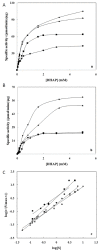Rationalization of allosteric pathway in Thermus sp. GH5 methylglyoxal synthase
- PMID: 23261063
- PMCID: PMC4133812
- DOI: 10.5483/bmbrep.2012.45.12.11-138
Rationalization of allosteric pathway in Thermus sp. GH5 methylglyoxal synthase
Abstract
A sequence of 10 amino acids at the C-terminus region of methylglyoxal synthase from Escherichia coli (EMGS) provides an arginine, which plays a crucial role in forming a salt bridge with a proximal aspartate residue in the neighboring subunit, consequently transferring the allosteric signal between subunits. In order to verify the role of arginine, the gene encoding MGS from a thermophile species, Thermus sp. GH5 (TMGS) lacking this arginine was cloned with an additional 30 bp sequence at the 3´-end and then expressed in form of a fusion TMGS with a 10 residual segment at the C-terminus (TMGS(+)). The resulting recombinant enzyme showed a significant increase in cooperativity towards phosphate, reflected by a change in the Hill coefficient (nH) from 1.5 to 1.99. Experiments including site directed mutagenesis for Asp-10 in TMGS and TMGS(+), two dimentional structural survey, fluorescence and irreversible thermoinactivation were carried out to confirm this pathway.
Figures



Similar articles
-
Cloning, expression, and characterization of a novel methylglyoxal synthase from Thermus sp. strain GH5.Appl Biochem Biotechnol. 2010 Nov;162(6):1519-28. doi: 10.1007/s12010-010-8933-0. Epub 2010 Apr 25. Appl Biochem Biotechnol. 2010. PMID: 20419481
-
Transmitting the allosteric signal in methylglyoxal synthase.Protein Eng Des Sel. 2013 Jul;26(7):445-52. doi: 10.1093/protein/gzt014. Epub 2013 Apr 16. Protein Eng Des Sel. 2013. PMID: 23592737
-
An alternative allosteric pathway in thermophilic methylglyoxal synthase.Int J Biol Macromol. 2016 Dec;93(Pt A):526-533. doi: 10.1016/j.ijbiomac.2016.09.013. Epub 2016 Sep 5. Int J Biol Macromol. 2016. PMID: 27608544
-
Amino acid biosynthesis: new architectures in allosteric enzymes.Plant Physiol Biochem. 2008 Mar;46(3):325-39. doi: 10.1016/j.plaphy.2007.12.006. Epub 2007 Dec 31. Plant Physiol Biochem. 2008. PMID: 18272376 Review.
-
The enzymology of cystathionine biosynthesis: strategies for the control of substrate and reaction specificity.Arch Biochem Biophys. 2005 Jan 1;433(1):166-75. doi: 10.1016/j.abb.2004.08.024. Arch Biochem Biophys. 2005. PMID: 15581575 Review.

